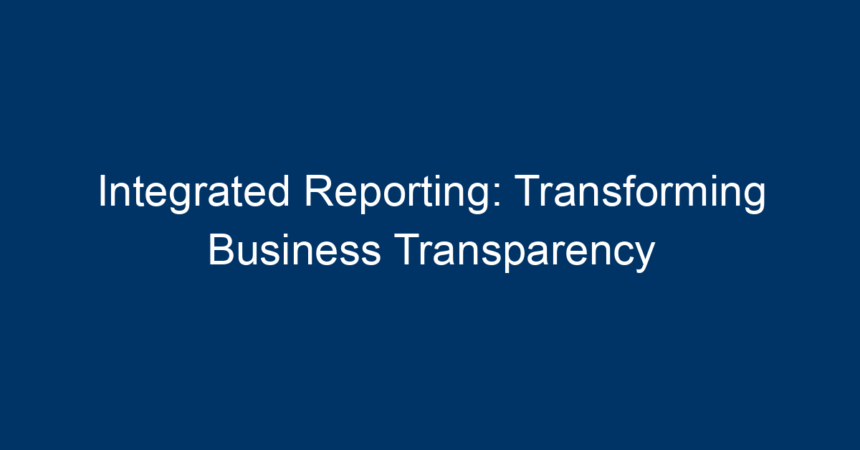In an era where businesses are scrutinized more than ever, integrated reporting has emerged as a groundbreaking approach to transparency. Companies are no longer assessed solely on financial performance; stakeholders are demanding insight into how businesses create value over time. Integrated reporting provides a holistic view of an organization, blending traditional financial data with non-financial information, such as environmental, social, and governance (ESG) factors. This article explores what integrated reporting is, its benefits, challenges, and how it is reshaping business accountability.
What is Integrated Reporting?
Definition and Purpose
Integrated reporting is a comprehensive framework that combines financial and non-financial data to present a clear picture of an organization’s strategy, governance, performance, and prospects. The primary purpose is to communicate how sustainability initiatives and business strategy intersect, informing stakeholders about the company’s ability to create long-term value.
The Framework
The International Integrated Reporting Council (IIRC) established the integrated reporting framework, which outlines key components of effective reporting, including:
- Organizational overview and external environment
- Business model
- Governance structure
- Stakeholder relationships
- Risks and opportunities
- Performance metrics
- Future Outlook
By intertwining these elements, integrated reports provide a narrative that reflects the organization’s overall health and strategic direction.
Why Integrated Reporting Matters
Enhancing Transparency
In today’s complex economic landscape, transparency is paramount. Stakeholders—from investors to customers—want to understand not just the “what” but also the “how” of a company’s operations. Integrated reporting fosters trust by revealing both financial successes and challenges faced by businesses.
Driving Strategic Decision-Making
Integrated reporting encourages organizations to adopt a long-term perspective in their strategic planning. By incorporating non-financial indicators, businesses can make informed decisions that align with their sustainability goals and stakeholder expectations. This holistic approach often leads to more resilient business models and better risk management.
Meeting Regulatory and Stakeholder Demands
Regulatory bodies worldwide are increasingly mandating more disclosure regarding ESG factors. Integrated reporting helps organizations meet these demands while simultaneously enhancing their reputations. Businesses adopting integrated reporting can distinguish themselves in competitive markets, appealing to ethically minded consumers and investors.
The Benefits of Integrated Reporting
Improved Performance
Companies that embrace integrated reporting often see improved operational efficiency. By analyzing various performance metrics, businesses can identify areas for improvement that impact both financial and non-financial aspects. This can lead to substantial cost savings and higher productivity levels.
Increased Stakeholder Engagement
Integrated reporting drives better engagement with stakeholders. Organizations that provide transparency and demonstrate their commitment to sustainability foster stronger relationships with their investors, employees, and customers. This can lead to enhanced loyalty and a more extensive support network.
Better Risk Management
When businesses adopt an integrated approach to reporting, they become better equipped to identify and mitigate risks associated with environmental and social factors. This proactive stance can help companies navigate uncertainties and prepare for future challenges, contributing to their long-term viability.
Challenges in Implementing Integrated Reporting
Knowledge Gaps
One of the foremost challenges organizations face when transitioning to integrated reporting is the lack of knowledge and expertise. Many companies might find it daunting to understand how to integrate non-financial metrics with financial data effectively. Training sessions and workshops can help bridge this knowledge gap.
Data Collection and Consistency
Collecting relevant data for integrated reporting can be challenging, especially for organizations that do not have established frameworks in place. Ensuring consistency and accuracy across various reporting dimensions is crucial but may require significant investment in time and resources.
Resistance to Change
Culture plays a significant role in the adoption of integrated reporting. Employees and management accustomed to traditional reporting paradigms may resist new approaches. Effective change management strategies, including communication and employee involvement, can smooth the transition.
Key Steps to Implement Integrated Reporting
1. Establish a Framework
Begin by familiarizing yourself with the integrated reporting framework as outlined by the IIRC. Identify the key components that resonate with your organization’s objectives and stakeholders.
2. Engage Stakeholders
Consult with various stakeholders—including investors, employees, and customers—to understand their information needs and expectations. Their insights can help shape the content and focus of your integrated report.
3. Gather Relevant Data
Invest in tools and technology to collect, analyze, and report relevant data that reflects both financial and non-financial performance. This includes metrics related to sustainability, governance, and community impact.
4. Collaborate Across Departments
Integrated reporting is not solely the responsibility of the finance department. Encourage collaboration across departments to ensure a comprehensive perspective is captured. Marketing, HR, and operations should all contribute to the narrative.
5. Measure and Report
Once the data is gathered and analyzed, create a report that clearly communicates your organization’s performance and strategy. Use visual aids, dashboards, and clear language to enhance understanding.
6. Continuous Improvement
Integrated reporting is not a one-time effort. Regularly assess and refine your reporting processes based on stakeholder feedback, changing regulations, and evolving business strategies.
The Future of Integrated Reporting
The future of integrated reporting looks promising, with growing acknowledgment of its importance in fostering transparency and accountability. As businesses increasingly recognize that long-term value creation is dependent on sustainability, integrated reporting is likely to become a standard practice.
Technology’s Role
Emerging technologies, such as AI and blockchain, may significantly impact integrated reporting. By automating data collection and enhancing traceability, technology can help streamline the reporting process, making it more efficient and accurate.
Global Trends
Countries worldwide are moving toward tighter reporting regulations around ESG factors. Businesses that proactively embrace integrated reporting will find themselves ahead of compliance requirements and better equipped to face global challenges, such as climate change and social inequalities.
Conclusion: Actionable Insights for Businesses
Integrating financial and non-financial reporting is more than a trend; it’s an essential strategy for businesses aiming for sustainable growth. By adopting integrated reporting, organizations can enhance their transparency, drive strategic decisions, and better engage with stakeholders.
Action Steps:
- Educate Your Team: Offer training on the principles of integrated reporting to foster a culture of transparency.
- Identify Key Stakeholders: Engage with your stakeholders to understand their reporting requirements.
- Leverage Technology: Use tools to streamline your data collection and reporting processes.
- Commit to Innovation: Continuously seek feedback and be willing to adapt your reporting practices in response to changing business landscapes.
In a world where consumers and investors are increasingly prioritizing sustainability, integrated reporting can serve as your organization’s roadmap to success. Embrace it today to pave the way for a more transparent and accountable future.




